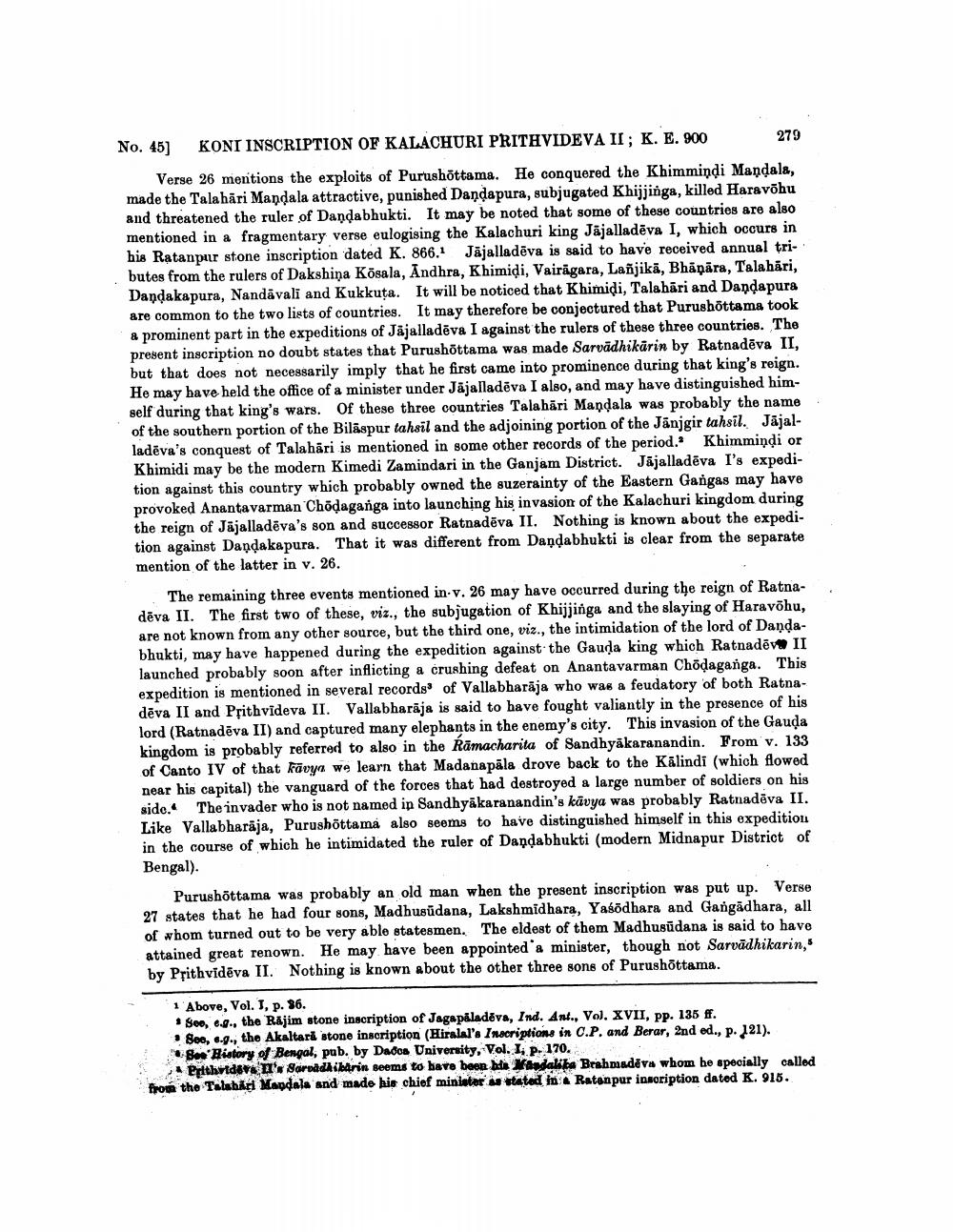________________
No. 45]
KONI INSCRIPTION OF KALACHURI PRITHVIDEVA II; K. E. 900
Verse 26 mentions the exploits of Purushottama. He conquered the Khimmindi Mandala, made the Talahari Mandala attractive, punished Dandapura, subjugated Khijjinga, killed Haravōhu and threatened the ruler of Dandabhukti. It may be noted that some of these countries are also mentioned in a fragmentary verse eulogising the Kalachuri king Jajalladeva I, which occurs in his Ratanpur stone inscription dated K. 866. Jajalladeva is said to have received annual tributes from the rulers of Dakshina Kōsala, Andhra, Khimidi, Vairāgara, Lañjikā, Bhāpāra, Talahari, Dandakapura, Nandavali and Kukkuta. It will be noticed that Khimidi, Talahari and Dandapura are common to the two lists of countries. It may therefore be conjectured that Purushottama took a prominent part in the expeditions of Jajalladeva I against the rulers of these three countries. The present inscription no doubt states that Purushottama was made Sarvadhikarin by Ratnadēva II, but that does not necessarily imply that he first came into prominence during that king's reign. He may have held the office of a minister under Jäjalladeva I also, and may have distinguished himself during that king's wars. Of these three countries Talahari Mandala was probably the name of the southern portion of the Bilaspur tahsil and the adjoining portion of the Janjgir tahsil. Jajalladeva's conquest of Talahari is mentioned in some other records of the period. Khimminḍi or Khimidi may be the modern Kimedi Zamindari in the Ganjam District. Jajalladēva I's expedition against this country which probably owned the suzerainty of the Eastern Gangas may have provoked Anantavarman Chodaganga into launching his invasion of the Kalachuri kingdom during the reign of Jajalladeva's son and successor Ratnadeva II. Nothing is known about the expedition against Dandakapura. That it was different from Dandabhukti is clear from the separate mention of the latter in v. 26.
279
The remaining three events mentioned in-v. 26 may have occurred during the reign of Ratnadēva II. The first two of these, viz., the subjugation of Khijjinga and the slaying of Haravōhu, are not known from any other source, but the third one, viz., the intimidation of the lord of Dandabhukti, may have happened during the expedition against the Gauda king which Ratnadev II launched probably soon after inflicting a crushing defeat on Anantavarman Chōdaganga. This expedition is mentioned in several records of Vallabharaja who was a feudatory of both Ratnadēva II and Prithvideva II. Vallabharaja is said to have fought valiantly in the presence of his lord (Ratnadēva II) and captured many elephants in the enemy's city. This invasion of the Gauḍa kingdom is probably referred to also in the Ramacharita of Sandhyakaranandin. From v. 133 of Canto IV of that kavya we learn that Madanapala drove back to the Kalindi (which flowed near his capital) the vanguard of the forces that had destroyed a large number of soldiers on his side. The invader who is not named in Sandhyakaranandin's kavya was probably Ratnadeva II. Like Vallabharaja, Purushottama also seems to have distinguished himself in this expedition in the course of which he intimidated the ruler of Danḍabhukti (modern Midnapur District of Bengal).
Purushottama was probably an old man when the present inscription was put up. Verse 27 states that he had four sons, Madhusudana, Lakshmidhara, Yasodhara and Gangadhara, all of whom turned out to be very able statesmen. The eldest of them Madhusudana is said to have attained great renown. He may have been appointed a minister, though not Sarvadhikarin, by Prithvidēva II. Nothing is known about the other three sons of Purushottama.
1 Above, Vol. I, p. 36.
See, eg., the Rajim stone inscription of Jagapaladeva, Ind. Ant., Vol. XVII, pp. 135 ff.
See, e.g., the Akaltara stone inscription (Hiralal's Inscriptions in C.P. and Berar, 2nd ed., p. 121). See History of Bengal, pub. by Dados University, Vol. I, p. 170.
Prithvideva II's Sarvadhibärin seems to have been his Mandalika Brahmadiva whom he specially called from the Talahari Mandala and made his chief minister as stated in a Ratanpur inscription dated K. 915.




